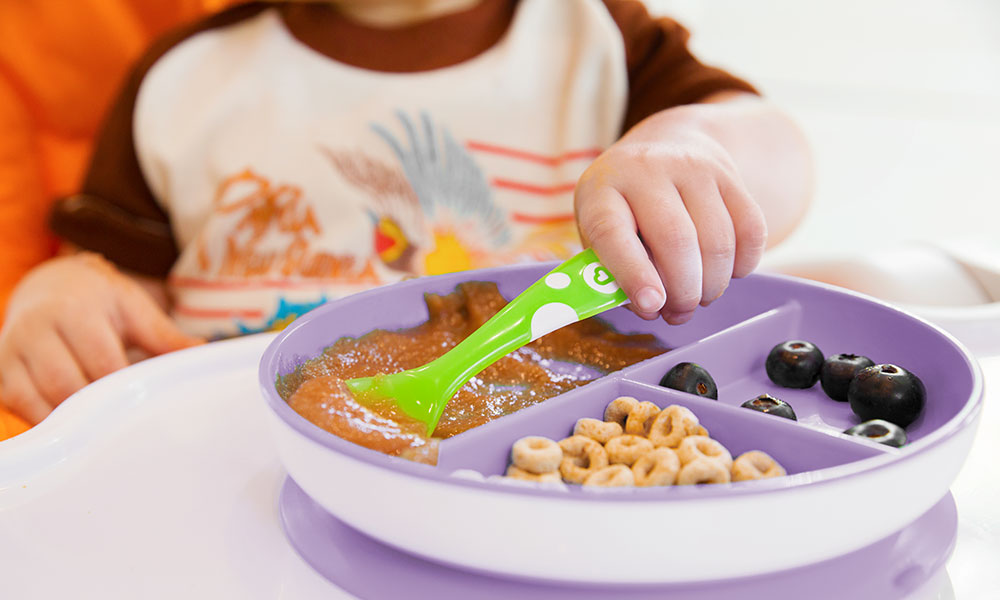With babies, timing is everything. How long are they napping for? Are they sleeping through the night yet? At what age will they roll over? As a new parent, you’ll start to feel like everything in your new life revolves around timing and routine. And for a long while it will.
So, on the subject of timings and milestones, let’s have a look at some key baby development stages to look out for – some of them are definitely fun ones too. Of course every baby is different, but the below should offer some helpful guidance.
Moving from bottle feeding to a sippy cup
So, when should you first introduce a sippy cup? It’s a good idea to introduce your baby to a sippy cup early. We recommend around six months, as it will make it easier to fully wean them off the bottle by the time they turn one. You might find that your baby naturally starts to lose interest in the bottle at around nine months to a year anyway.
Knowing when to wean is one thing, how you do it is a whole different ball game. Top tips include:
- Using a Gentle Transition Trainer cup with a silicone spout
- Always offering the cup over the bottle to get baby used to the cup
You might also want to consider going cold turkey, but this isn’t for everyone. Our guide on how to transition your baby from bottle to sippy cup has some additional tips.
When to start introducing solid foods
You should start introducing your baby to solid foods at around six months old. Up until this age, breast milk or formula will provide the energy and nutrients your baby needs. After six months, it’s important that they get this from their food too. By combining a variety of foods alongside milk (breast or formula), you’ll be setting your baby up early in their development.
When you first start off, it’s not about how much food they eat, more that they get used to the idea of eating. They’ll still get most of their nutrients and energy from milk, so it’s more about learning a new skill at first. Gradually you can increase the amount and variety of foods as they get more used to eating. They can even sit with the rest of the family to enjoy their small portions too.
And when it comes time for weaning, you’ll need the right equipment at hand. Our weaning bundles are ideal.
How long to keep a baby in a bouncer or swing
A bouncer or swing is a great bit of baby kit. They can enjoy some quiet time in their swing, while you can get some quiet time of your own. Or it gives you a chance to crack on with some jobs or make some food. But how long can a baby stay in a swing? And can they sleep in it?
First things first, you should never let your baby sleep in a bouncer or swing. If your little one falls asleep, you should move them to a safe, flat sleeping place as quickly as possible. And whilst they’re awake, try and limit time in their bouncer to 15-30 minute bursts – this will make sure that they’re safe at all times when using it.
Getting those baby gates up
As soon as baby starts trying to move it’s time to babyproof the stairs and fence off any rooms that you want to keep out of bounds. Babies can start crawling between seven to 10 months, with most doing it around the nine month stage.
Once they become mobile, you’ll want to place a stair gate at the top and bottom of the stairs to stop them attempting to crawl up the stairs or falling down. You can also place stair gates in doorways too, limiting their access to certain rooms.
When it comes to taking your stair gates down, according to EU guidelines you should do this when your child is two. In reality it all depends on their development. If they can climb over the stair gate, or dislodge it, they could injure themselves. It’s at this stage that having stair gates in place can actually become more dangerous. You’ll know when the time comes to take them down.
Moving from a cot to a toddler bed
Again this one all depends on your child. They can move to a toddler bed from a cot as early as 18 months or as late as three and a half. Most parents wait until their little one is around two.
Every toddler takes to a change in their bed differently. For some it will be a smooth transition, for others it will take a little time. It’s a good idea to approach the idea with them a couple of weeks before making the change. Referring to it as a “big girl” or “big boy” bed is always helpful too, as is bringing plenty of their soft toys with them and familiar blankets from their cot. Just remember it may take time for the transition to run smoothly, so don’t put too much pressure on them or you.
It’s always important to remember your baby is an individual and will take to things at different times. Whilst it’s important to know the guidelines of when they should be doing certain things, it’s also crucial to respond to them and work with their personal wants and needs. You’ll know when they’re ready!
Looking for more baby advice? Head over to our blog or listen to our StrollerCoaster podcast.

Leave a Reply